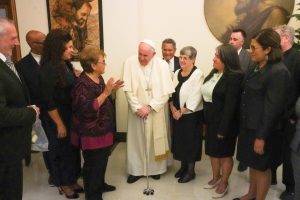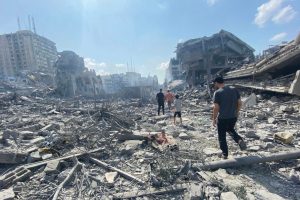SANTO DOMINGO, Dominican Republic – Just one day after the 7.0 magnitude earthquake struck Haiti, the Claretian Missionaries religious order in Santo Domingo assembled a convoy to head into the destruction and assist their fellow Claretians and the community they serve in Port-au-Prince, Haiti. The group was led by Claretian Father Hector Cuadrado, the major superior of the order's Antilles Province, which includes Haiti.
The convoy made its first stop at the Claretian mission house in Jimani, a town on the Dominican side of the Dominican-Haitian border. Originally set up as a shelter for the needy, the Claretian mission house had now been turned into a makeshift medical clinic. Workers there were busy doing everything possible to treat the thousands of injured being brought from Haiti.
The Claretians lent support to the Dominican doctors and nurses. They witnessed the heartbreaking scene of a Haitian boy, 11 years old, who was wailing not only from his injuries but because his mother was gone and he had no idea where she was. Before heading on, they also visited the St. Anthony Mary Claret Multipurpose Center in Jimani, where the injured were being treated.
Knowing that the smallest bit of help was extremely important at this critical time, border officials allowed everyone to cross from the Dominican Republic into Haiti without the usual formalities. The Claretian convoy made its way to St. Antoine Marie Claret Church, the Claretian parish in the Nazon district of Port-Au-Prince, where Father Anistus Chima Onuoha, C.M.F. has been pastor for several years. The Nazon district, a neighborhood northeast of downtown Port-au-Prince, is one of the poorest areas of the city.
 The devastation they saw when they arrived at the parish was overwhelming. "The vast majority of concrete structures had collapsed completely," said Cuadrado. When they finally reached Anistus, "he was absolutely overjoyed and then began crying, letting everyone see his mixed feelings of sorrow, frustration, confusion, happiness, and gratitude."
The devastation they saw when they arrived at the parish was overwhelming. "The vast majority of concrete structures had collapsed completely," said Cuadrado. When they finally reached Anistus, "he was absolutely overjoyed and then began crying, letting everyone see his mixed feelings of sorrow, frustration, confusion, happiness, and gratitude."
The Claretian mission house had huge cracks, which would hardly withstand another aftershock. In fear of the house's instability, people were sleeping outside on the patio, along with a few acquaintances and neighbors who had lost everything.
"It is unbelievable what we experienced and that we are still living. Please pray for us. We are in deep trouble, many deaths, bodies scattered everywhere, houses crumbled with people still inside," said a weary Anistus. "It is a total disaster. The capital cannot be recognized, and we are living and sleeping on the streets because the houses that are still standing are in bad shape. May God help us!"
The Claretians toured the Nazon district of Port-au-Prince to see what remained of the buildings of the St. Antoine Mary Claret Parish. The four Claretians who serve the parish survived and were out on the streets along with everyone else.
 The ten-year-old church and the public elementary school that the Claretians helped to build were destroyed. The earthquake had undone ten years of work. But Cuadrado said, "The spiritual building we and the people of Nazon have built over the years continues to produce the best of fruit at this critical moment."
The ten-year-old church and the public elementary school that the Claretians helped to build were destroyed. The earthquake had undone ten years of work. But Cuadrado said, "The spiritual building we and the people of Nazon have built over the years continues to produce the best of fruit at this critical moment."
The parish caretaker, an old man who at the time of the quake was inside the church on the second floor, miraculously survived. When the building collapsed, he managed to slide into a safe place.
Forty-eight hours after the quake, chaos reigned all across the city and international assistance had yet to arrive. People aimlessly wandered the streets, hunkering down in parks, fields, and gasoline stations. Thousands of refugees had no roof over their heads. Decomposing corpses were on every street corner and groups of people looked for survivors in the debris.
"Every time I go out and see the city I ask myself: Am I dreaming, or is what I see true? Is this the Port-au-Prince that I have known?" asked Anistus. "But it is not a dream; it is a reality. How did we survive? Why did the house not fall on us? There are so many questions that other people cannot ask because they are no longer with us.
 "The archbishop with other priests, sisters, seminarians, and lay persons all died, and many churches in Port-au-Prince collapsed," Anistus added. "We continue to sleep in the courtyard of our house. We cannot sleep inside because it is too dangerous."
"The archbishop with other priests, sisters, seminarians, and lay persons all died, and many churches in Port-au-Prince collapsed," Anistus added. "We continue to sleep in the courtyard of our house. We cannot sleep inside because it is too dangerous."
After touring Port-au-Prince and assisting in the relief efforts, the Claretian convoy traveled back to Santo Domingo where ten Haitian seminarians still had not heard any news about their families. The Claretians decided to send the young men in search of their loved ones. Although their level of fear and anxiety was considerable, the mutual support of the Claretian community has helped them to maintain their faith and fortitude in these moments.
Before the seminarians departed, the Claretians in Santo Domingo held a community meeting and prayer, in which they sang psalms, listened and shared the Word, and helped the seminarians prepare for the trip to meet with their dramatic reality.
"Among the ideas that I shared with them were these: that we are men of faith and hope, because we bring Jesus Christ in our heart," said Cuadrado. "The hard and difficult situation they are going to confront will certainly impress them and the uncertainty of not knowing what they are going to find there. I cannot describe my feelings in sending our sons to confront face to face with what they have only seen on television."
A few days later, the seminarians located their families and were in the process of returning to the Claretian seminary in Santo Domingo. They were pained and saddened at the death of the mother of one of the seminarians, several of his small cousins and nephews and a baptismal godmother.
 "The Haitian people have always been in the heart of our mother congregation," said Cuadrado. "Many ask themselves why God permitted all this. However, we want to ask them: Are they not seeing Him acting in the love and solidarity of so many?"
"The Haitian people have always been in the heart of our mother congregation," said Cuadrado. "Many ask themselves why God permitted all this. However, we want to ask them: Are they not seeing Him acting in the love and solidarity of so many?"
The long-term challenge now facing Haiti is the rebuilding of the infrastructure and government institutions. While millions of dollars have been raised to support the island nation, Father Rosendo Urrabazo, C.M.F. is concerned about the long-term support for Haiti as time passes. Urrabazo visited the Haitian Claretian community last year, when he was the Claretian General Vicar. "The outpouring of the international community has been remarkable," he said. "It shows the people of Haiti and the rest of the world that humanity is alive. But rebuilding will be a long-term process.
"The challenge is not just to restore the lives of the Haitian people, but to rebuild their institutions," Urrabazo added. "It's going to take generations, and the vision of the church is certainly long term.
"There were many social and political problems that needed to be sorted out even before this tragedy. But the only institution that seems to work in Haiti is the Catholic Church. After all the aid organizations are gone, the church will still remain, and the people's faith is what is going to get them through this."
Images: Top photo shows the rubble at St. Anthony Mary Claret Church in Port-au-Prince is all that remains of the 10-year-old parish. Photos courtesy of Claretian Missionaries religious order in Santo Domingo.














Add comment